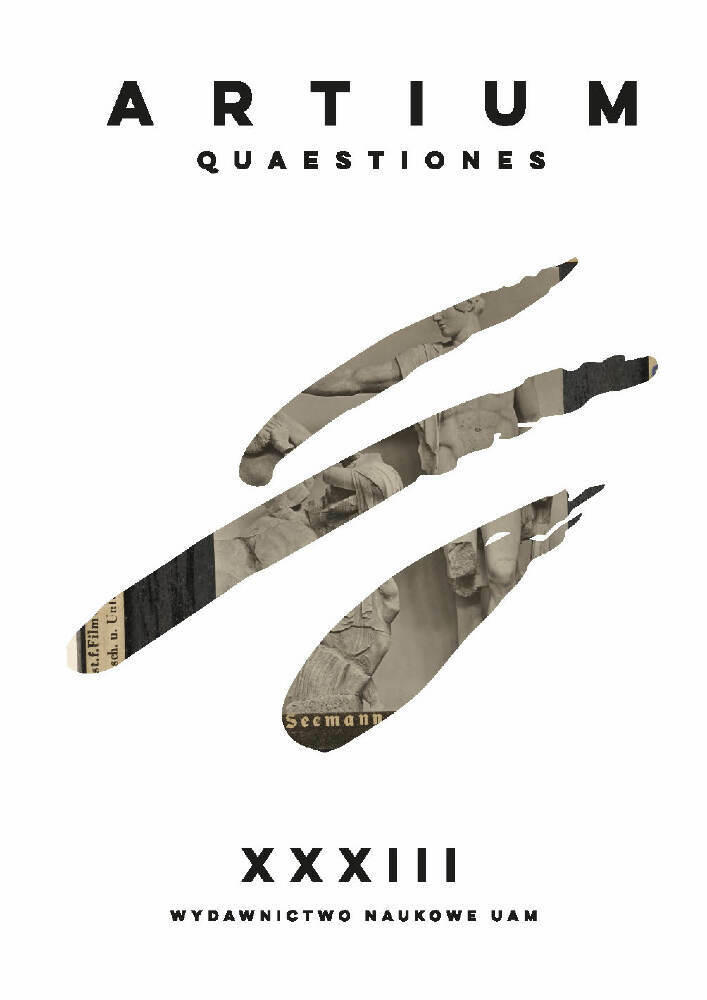Abstract
The issue of the relationship between art history, its analytical procedures and critical judgements, and the attitude of art historians to modern art has long been a problem discussed when we refer, for example, to scholars such as Riegl, Wölfflin, and, for obvious reasons, Justi or Sedlmayr. Although many art historians reacted very negatively to their own contemporary artistic phenomena, of which Justi’s aversion to Impressionism was perhaps the most notable example, the issue is by no means clear-cut. It is important to note here that even critical remarks made against distinct phenomena in modern art need not be tantamount to a condemnation of “modernity”. Edgar Wind, an outstanding methodologist of science and an excellent art historian of the 18th century and the Renaissance, seems to be a particularly interesting example here. Criticising various manifestations of the cult of “pure form”, and associating them with the influence of Romantic “autonomy” of art creation and certain concepts from the sphere of art history as a discipline, Wind was at the same time a very insightful observer of contemporary art, valuing selected artists highly. This issue was presented in detail by Ben Thomas in his recently published book on Wind’s attitude to contemporary art, drawing on Wind’s previously unpublished and unknown materials. The present text is an attempt at a broader, problematising discussion of this issue on the basis of reading Ben Thomas’s book, the publication of which should be regarded as an important event in the field of research into the history of art, history of art history, and the influence exerted by art history as a practice and as a discipline on the problem of esteeming modern art.
References
Benardete S., Plato’s ‘Laws’. The Discovery of Being, Chicago–London 2000 https://doi.org/10.7208/chicago/9780226829951.001.0001
Brown M., The Classic is the Baroque: On the Principle of Wölfflin’s Art History, „Critical Inquiry” 1982, 9, 2, s. 379–404 https://doi.org/10.1086/448206
Buschendorf B., Nachwort, w: E. Wind, Das Experiment und die Metaphysik, red. i posłowie B. Buschendorf, wprowadzenie B. Falkenburg, Frankfurt am Main 2001
Buschendorf B., Pojęcie symbolu u Friedricha Theodora Vischera, Aby’ego Warburga i Edgara Winda, tłum. T. Ososiński, w: Aby Warburg. Panorama recepcji, wybrał, wstępem opatrzył i przekłady przejrzał R. Kasperowicz, Gdańsk 2020, s. 281–312
Edgar Wind – Kunsthistoriker und Philosoph. Hrsg. von H. Bredekamp, Belin 1998 [obszerny zbiór artykułów, poświęconych różnym aspektom myśli filozoficznej i praktyce historyczno-artystycznej Winda]
Ferretti S., Cassirer, Panofsky and Warburg. Symbol, Art, and History, tłum. R. Pierce, New Haven–London 1989 https://doi.org/10.2307/431785
Gossman L., Jacob Burckhardt: Cold War Liberal?, „The Journal of Modern History” 2002, 74, 3, s. 538–572 https://doi.org/10.1086/345111
Grémion P., Konspiracja wolności: Kongres Wolności Kultury w Paryżu (1950–1975), tłum. J.M. Kłoczowski, Warszawa 2004
Heckscher W., Geneza ikonologii, tłum. R. Kasperowicz, w: Aby Warburg. Panorama recepcji, wybrał, wstępem opatrzył i przekłady przejrzał R. Kasperowicz, Gdańsk 2020, s. 167–189
Kemp W., Introduction, w: A. Riegl, The Group Portraiture of Holland, wstęp W. Kemp, tłum. E.M. Kain, D. Britt, Los Angeles 1999
Kuhn Th., Dwa bieguny. Tradycja i nowatorstwo w badaniach naukowych, tłum. i posłowiem opatrzył S. Amsterdamski, Warszawa 1985
Levine E.J., Dreamland of Humanists. Warburg, Cassirer, Panofsky and the Hamburg School, Chicago–London 2013 https://doi.org/10.7208/chicago/9780226061719.001.0001
Lilla M., G. B. Vico. The Making of the Anti-Modern, Cambridge, Mass. 1993Platon, Prawa, tłum. i oprac. M. Maykowska, wstęp T. Kozłowski, Warszawa 1997
Rampley M., Max Dvořák and the Crisis of Modernity, „Art History” 2003, 26, 2, s. 214–237 https://doi.org/10.1111/j.0141-6790.2003.02602010.x
Rosen S., The Quarrel Between Philosophy and Poetry. Studies in Ancient Thought, New York–London 1988
Sedlmayr H., Verlust der Mitte. Die bildende Kunst des 19. Und 20. Jahrhunderts als Symptom und Symbol der Zeit, Frankfurt/M 1973
Takaes I., ‘A Tract for the Times’ – Edgar Wind’s 1960 Reith Lectures, „Journal of Art Historiography” 2019, dostępny w internecie: <https://www.academia.edu/41144411/_A_Tract_for_the_Times_Edgar_Wind_s_1960_Reith_Lectures?email_work_card=view-paper> [dostęp: 12 września 2022]
The Laws of Plato, tłum. oraz komentarze i esej Thomas L. Pangle, Chicago–London 1980
Thomas B., Edgar Wind and Modern Art. In Defense of Marginal Anarchy, London–New York 2020 https://doi.org/10.5040/9781501355998
Winckelmann J.J., Werke in einem Band, ausgewählt und eingeleitet von H. Holtzhauer, Berlin–Weimar 1982
Wind E., Art and Anarchy, London 1963
Wind E., Pojęcie nauki o kulturze u Warburga i jego znaczenie dla estetyki, tłum. T. Ososiński, w: Aby Warburg. Panorama recepcji, wybrał, wstępem opatrzył i przekłady przejrzał R. Kasperowicz, Gdańsk 2020, s. 35–51
Wind E., The Maenad under the Cross. Comments on an Observation by Reynolds, w: idem, Hume and the Heroic Portrait. Studies in Eighteenth-Century Imagery, red. J. Anderson, Oxford 1986, s. 74–76
Wind E., Θείος Φόβος. Rozważania o filozofii sztuki Platona, tłum. R. Kasperowicz, „Kronos” 2020, 53, 2, s. 28–52
License

This work is licensed under a Creative Commons Attribution-NonCommercial-NoDerivatives 4.0 International License.
The copyrights are regulated by author's statement and publication agreement prepared by Adam Mickiewicz University Press. The authors are responsible for the originality of texts published and regulating the copyrights of accompanying visual materials, unless the materials come from the Editorial Team.
This work is available with the following licence: Attribution-NonCommercial-NoDerivatives 4.0 International License
Attribution-NonCommercial-NoDerivatives 4.0 International License

